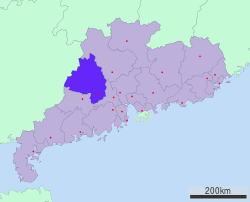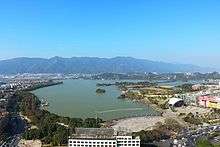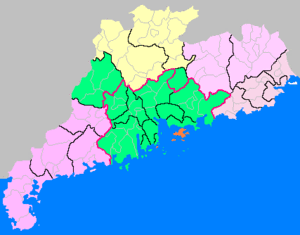Zhaoqing
| Zhaoqing 肇庆市 | |
|---|---|
| Prefecture-level city | |
|
Panorama view of Duanzhou District and Seven Star Crags | |
 Location of Zhaoqing City jurisdiction in Guangdong | |
 Zhaoqing Location in China | |
| Coordinates: 23°03′N 112°28′E / 23.050°N 112.467°E | |
| Country | People's Republic of China |
| Province | Guangdong |
| County-level divisions | 8 |
| Municipal seat | Duanzhou District |
| Area | |
| • Prefecture-level city | 14,891.23 km2 (5,749.54 sq mi) |
| • Urban | 706.4 km2 (272.7 sq mi) |
| • Metro | 2,339.6 km2 (903.3 sq mi) |
| Elevation | 12 m (39 ft) |
| Population (2010 census[1]) | |
| • Prefecture-level city | 3,918,467 |
| • Density | 260/km2 (680/sq mi) |
| • Urban | 644,032 |
| • Urban density | 910/km2 (2,400/sq mi) |
| • Metro | 1,232,462 |
| • Metro density | 530/km2 (1,400/sq mi) |
| Time zone | China Standard (UTC+8) |
| Area code(s) | 0758 |
| License Plate | 粤H |
| Major Nationalities | Han |
| Website | Zhaoqing official site |
| Zhaoqing | |||||||||||||
|
"Zhaoqing", as written in Chinese calligraphy | |||||||||||||
| Simplified Chinese | 肇庆 | ||||||||||||
|---|---|---|---|---|---|---|---|---|---|---|---|---|---|
| Traditional Chinese | 肇慶 | ||||||||||||
| Cantonese Jyutping | Siu6 hing3 | ||||||||||||
| Cantonese Yale | Siuhhing | ||||||||||||
| Hanyu Pinyin | Zhàoqìng | ||||||||||||
| Postal | Shiuhing | ||||||||||||
| Literal meaning | Beginning of auspiciousness | ||||||||||||
| |||||||||||||
Zhàoqìng (Chinese: 肇庆) is a prefecture-level city of Guangdong province, People's Republic of China and the southern districts and Sihui is considered part of the Pearl River Delta region. It is well known for being a regional tourist hub, a medium-sized provincial "college town" as well as an up-and-coming manufacturing center. Residents from Guangzhou, Shenzhen and other nearby cities, as well as people from Hong Kong and Macau, are known to visit the city on weekend getaways and excursions. Its population was 3,918,467 at the 2010 census whom 1,232,462 lived in the built-up (or metro) area made of Duanzhou urban District and Gaoyao County largely being urbanized.[1] Dinghu urban District is not yet conurbated. The main central city, excluding Seven Star Crags, is fairly flat, but thickly forested mountains lie just outside the city limits. Numerous rice paddies and aquaculture ponds are found on the outskirts of the city.
History and Name

The date of Zhaoqing's founding is uncertain, but it existed as early as the Qin (221–206 BC) and Han (206 BC – 220 CE) Dynasties, when it was known as Gaoyao (高要). In the Sui Dynasty (581–618), Zhaoqing became known as Duanzhou (端州) and served as an important administrative region and military base.
In 1118, Northern Song Dynasty Emperor Huizong bestowed its current name upon the city. "Zhaoqing" means "beginning of auspiciousness".
Early Jesuit mission
By the time of the Europeans arriving to Guangdong in the 16th century, Zhaoqing was an important administrative center, and the seat of Viceroy of Guangdong and Guangxi.[2]
Matteo Ricci account of the "Christian expeditions into China" tell about the early visits of Macau-based Europeans to Zhaoqing. The first visit may have been that by the Macau City Auditor Mattia Penella and the Italian Jesuit Michele Ruggieri, who went to Zhaoqing in 1582, sent there by the Macau's authorities in lieu of the Mayor and the Bishop of Macau, whom the Viceroy (named Chen Jui, 陈瑞) had summoned to report to him at his residence.[3] The Jesuits at the time were interested in expanding their missionary activity from Macau into Mainland China, so other visits by Jesuits soon followed, and by 1583, after several false starts, Michele Ruggieri and another, recently arrived Jesuit, named Matteo Ricci managed to establish residence in the city - the first Jesuit mission house in China outside Macau. Ruggieri and Ricci were able to move to the city after receiving an invitation from the governor of Zhaoqing at the time, Wang Pan, who had heard of Ricci's skill as a mathematician/cartographer.
It was in Zhaoqing that Ricci drew up the first ever map of the world in Chinese in 1584. In 1588, Ruggieri left China for Rome - not to ever return, as it turned out. But Ricci stayed in Zhaoqing until 1589, when a new viceroy decided to expel him from the city, and the Jesuit had to move to Shaozhou.[4]
There is now a memorial plaque in Zhaoqing to commemorate Ricci's six-year stay there as well as a building set up as a "Ricci Memorial Centre" although the building itself does not date back to the time of the priest as it was built in the 1860s.
The anti-Manchu resistance
After the fall of northern China to the Manchus in 1644, a sequence of Ming princes one after another established short-lived regimes at various locations in central and southern China, collectively known as the Southern Ming Dynasty. For several years until 1650, Zhaoqing was the seat of the last of these pretenders on the Ming throne, Zhu Youlang, styled the Yongli Emperor (who also made his court in Guilin and, later, at various locations in Guangxi, Yunnan, and Burma). The Jesuits Andreas Wolfgang Koffler and, later, Michał Boym stayed for some time at his court [5][6]
Geography and climate
Zhaoqing is located 110 km (68 mi) northwest of Guangzhou, in the west Pearl River Delta. It lies on the north shores of the Xi River, which flows from west to east, and opposite of Gaoyao. A plain area lies to the south and west of Zhaoqing, with mountains to the east and north.
The city has a monsoon-influenced humid subtropical climate (Köppen climate classification Cfa). The yearly average temperature is 22.3 °C (72.1 °F), and annual precipitation is 1,605 mm (63.2 in).
| Climate data for Zhaoqing (1971–2000) | |||||||||||||
|---|---|---|---|---|---|---|---|---|---|---|---|---|---|
| Month | Jan | Feb | Mar | Apr | May | Jun | Jul | Aug | Sep | Oct | Nov | Dec | Year |
| Record high °C (°F) | 28.7 (83.7) |
29.4 (84.9) |
32.4 (90.3) |
35.7 (96.3) |
36.1 (97) |
37.3 (99.1) |
38.1 (100.6) |
38.7 (101.7) |
38.3 (100.9) |
34.3 (93.7) |
32.8 (91) |
30.0 (86) |
38.7 (101.7) |
| Average high °C (°F) | 18.0 (64.4) |
18.4 (65.1) |
21.2 (70.2) |
25.7 (78.3) |
29.6 (85.3) |
31.8 (89.2) |
33.2 (91.8) |
33.0 (91.4) |
31.5 (88.7) |
28.6 (83.5) |
24.4 (75.9) |
20.5 (68.9) |
26.3 (79.4) |
| Daily mean °C (°F) | 13.9 (57) |
14.7 (58.5) |
18.0 (64.4) |
22.3 (72.1) |
25.8 (78.4) |
27.8 (82) |
28.9 (84) |
28.8 (83.8) |
27.4 (81.3) |
24.4 (75.9) |
19.7 (67.5) |
15.6 (60.1) |
22.3 (72.1) |
| Average low °C (°F) | 10.8 (51.4) |
12.2 (54) |
15.3 (59.5) |
19.8 (67.6) |
23.1 (73.6) |
25.1 (77.2) |
25.8 (78.4) |
25.8 (78.4) |
24.5 (76.1) |
21.2 (70.2) |
16.2 (61.2) |
12.0 (53.6) |
19.3 (66.8) |
| Record low °C (°F) | 2.3 (36.1) |
1.7 (35.1) |
4.4 (39.9) |
9.2 (48.6) |
14.9 (58.8) |
19.3 (66.7) |
22.7 (72.9) |
20.7 (69.3) |
15.9 (60.6) |
10.9 (51.6) |
5.4 (41.7) |
1.0 (33.8) |
1 (33.8) |
| Average precipitation mm (inches) | 40.9 (1.61) |
64.2 (2.528) |
81.3 (3.201) |
200.6 (7.898) |
276.0 (10.866) |
256.1 (10.083) |
229.5 (9.035) |
236.2 (9.299) |
143.0 (5.63) |
75.3 (2.965) |
37.5 (1.476) |
30.8 (1.213) |
1,671.4 (65.804) |
| Average precipitation days (≥ 0.1 mm) | 8.2 | 12.3 | 15.9 | 17.4 | 19.9 | 18.9 | 17.2 | 17.4 | 12.4 | 6.7 | 5.5 | 5.3 | 157.1 |
| Source: Weather China | |||||||||||||
Administration
Zhaoqing has jurisdiction over 3 districts, 4 counties and 1 County-level city:
| Map | Name | Simplified Chinese | Hanyu Pinyin | Population (2010 census) |
Area (km2) |
Density (/km2) | |||||
|---|---|---|---|---|---|---|---|---|---|---|---|
| Duanzhou District | 端州区 | Duānzhōu Qū | 479,342 | 153.99 | 3,113 | ||||||
| Dinghu District | 鼎湖区 | Dǐnghú Qū | 164,690 | 552.39 | 298 | ||||||
| Gaoyao District | 高要区 | Gāoyào Qū | 753,120 | 2,185.62 | 345 | ||||||
| Guangning County | 广宁县 | Guǎngníng Xiàn | 423,941 | 2,455.46 | 173 | ||||||
| Huaiji County | 怀集县 | Huáijí Xiàn | 813,032 | 3,554.07 | 229 | ||||||
| Fengkai County | 封开县 | Fēngkāi Xiàn | 398,258 | 2,723.93 | 146 | ||||||
| Deqing County | 德庆县 | Déqìng Xiàn | 341,211 | 2,002.8 | 170 | ||||||
| Sihui | 四会市 | Sìhuì Shì | 542,873 | 1,262.96 | 430 | ||||||
Economy
Primary industries
The rich local resources within the mountainous regions include coal, limestone, copper, lead, zinc, granite, gold, sulfur, gypsum and other minerals.
In the agriculture sector, the fertile plains yield paddy rice, sugar cane, aquatic products, fruits, rosin and cassia bark. Horticulture and farming contribute greatly to the local economy. The industries of Poultry farming and animal husbandry are also seeking to modernize their technology and management.
The forests in the mountainous regions of the city provide a rich source for herbal medicines and other materials like rosin and casia bark that are harvested from various forest plants.
Secondary industries
Food and beverages, building materials, electronics, micro bioengineering, chemicals, equipment and machinery, textile and garments are the pillar industries. Duanzhou, Gaoyao and Sihui area being developed as the export-oriented industrial bases. Yunfu is a major area for the production of sulfur and iron.
To facilitate industrial development in Zhaoqing, the local government has made great efforts in establishing various industrial zones / parks in the city. The largest one is the Guangdong Zhaoqing High-tech Industrial Development Zone, with an area of 109 km2 (42 sq mi), that consists of two industrial parks, Sanrong Industrial Park and Dawang Industrial Park, of areas 9 km2 (3.5 sq mi) and 100 km2 (39 sq mi) respectively. Dawang is facilitated as an export processing and trade zone.
The 10 Projects
The Zhaoqing local government attracts capital investment by promoting the city to private and foreign investors, and by developing industrial parks in modern standard. Making the best use of its natural environment, Zhaoqing aims to become a garden city, ecological city and modernized large city in China.
In five year's time (2003–2007), the city government will implement 10 big projects:
- Expansion of urban proper towards the east and the south with the best urban planning, construction, and management.
- Developing the eastern and southern industrial areas to become a modern manufacturing base of the world.
- Promoting economic development in the hilly areas and counties and upgrade their industrial zones.
- Construction of an industrial corridor of science, technology, education and culture to nurture knowledge economy, through developing technology park and university park, and inter-university cooperation
- Increasing capital investment for infrastructure construction.
- Promoting the reform and development of state owned enterprises.
- Developing tourism spots and industry.
- Construction of an "education city" and a "cultural city" to enhance the quality of human resources.
- Construction of "digital Zhaoqing".
- Enhancing environmental protection.
Companies with a presence in Zhaoqing
- China Pabst Blue Ribbon (Chinese: 蓝带啤酒; pinyin: Lán dài píjiǔ)
Education
The city government of Zhaoqing is currently seeking to improve its higher education system and preserve cultural resources. Zhaoqing has a university and is also home to a campus of Guangdong University of Finance. There is also Zhaoqing Foreign Language College, a Canadian-American School and numerous other schools including those specializing in foreign language study.
Colleges and universities
- Zhaoqing University
- Zhaoqing Foreign Language College
Transportation
Zhaoqing is served by railways and highways. Direct train and bus services connect it to Guangzhou, Hong Kong and other cities in Guangdong. Major roadways include Interstates 321 and 324 and the Guang-Zhao and Guang-Wu Expressways. The Sanmao Railway also runs through Zhaoqing. It is connected with Hong Kong via the KCRC Guangdong Through Train service from Zhaoqing Railway Station. Hong Kong owned and based Chu Kong Passenger Transport Co., Ltd also runs daily express catamaran ferries between Zhaoqing and Hong Kong.
Within the city, the primary form of public transportation is the 28 public bus routes.
References
- 1 2 http://www.citypopulation.de/php/china-guangdong-admin.php
- ↑ De Christiana expeditione apud Sinas, Book Two, Chapter 3. Pages 136 in the English translation: Louis J. Gallagher (1953). "China in the Sixteenth Century: The Journals of Matteo Ricci", Random House, New York, 1953. The original Latin text by Nicolas Trigault, De Christiana expeditione apud Sinas suscepta ab Societate Jesu, can be found on Google Books.
- ↑ Gallagher (trans.), p. 136. Chen Jui is Cinsui in Ricci's transcription
- ↑ Gallagher (trans.), pp. 205-229.
- ↑ Andreas Wolfgang Koffler in The Dictionary of the Ming Biography, pp. 722-723
- ↑ Mungello, David E. (1989). Curious Land: Jesuit Accommodation and the Origins of Sinology. University of Hawaii Press. p. 139. ISBN 0-8248-1219-0.
External links
| Wikimedia Commons has media related to Zhaoqing. |
| Wikivoyage has a travel guide for Zhaoqing. |
- Zhaoqing Government website
- Zhaoqing University website (in Chinese and English)
- Zhaoqing Foreign Language College website
- Guangdong University of Finance website (in Chinese and English)
- News Guangdong Zhaoqing page
- The Zhaoqing Ricci center
- Matteo Ricci and his contributions to science in China
- Map of the city center
- Chu Kong Passenger Transport Co. Ltd.
| ||||||||||||||||||||||||||||||||||||||||||||||||||||||||||||||||||||||||||||||||||||||||||||||||||||||||||||||||||||||
| |||||||||||||||||
| ||||||||||||||||||||||||||||||||||||||||||||||||||||||||||||||||||||||||||||||||||||||||||||||||||||||||||||||||||||||
|


